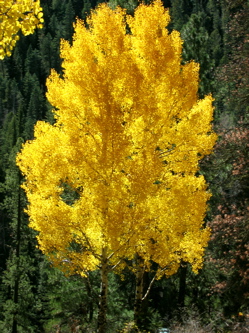
Loneliness & Presence: What the Aspen Know
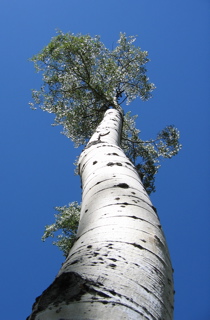 There is an interesting recent post over at the biosingularity blog site titled, Loneliness is Bad for Your Health, where they report on an article in the August issue of Current Directions in Psychological Science, a journal of the Association for Psychological Science.
There is an interesting recent post over at the biosingularity blog site titled, Loneliness is Bad for Your Health, where they report on an article in the August issue of Current Directions in Psychological Science, a journal of the Association for Psychological Science.
However, when the psychologists looked at the lives of the middle-aged and old people in their study, they found that although the lonely ones reported the same number of stressful life events, they identified more sources of chronic stress and recalled more childhood adversity. Moreover, they differed in how they perceived their life experiences. Even when faced with similar challenges, the lonelier people appeared more helpless and threatened. And ironically, they were less apt to actively seek help when they are stressed out. (emphasis mine)
Cellular biologist Bruce Lipton, in The Biology of Belief, demonstrates how it is our perception of our environment, as opposed to the environment itself, that determines our response to it. It is even the mother’s perception of that environment that feeds into her fetus’ development for living in a world of nurturance or a world of threat.
Anticipating a world of nurturance breeds greater forebrain development while anticipating a world of threat breeds what mice researchers call “warrior mice”, i.e. larger musculature and smaller forebrains. The forebrain by the way is the source of our so called higher human intelligences. Joseph Chilton Pearce, in The Biology of Transcendence, reports on this material and its implications.
What I want to focus on here however is the idea that loneliness is bred out of our sense of separation of self, our lack of healthy connectedness, our experience of not belonging in the world…. As physicist David Bohm wrote: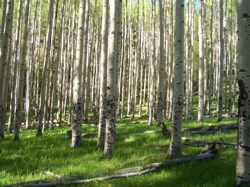
For fragmentation is now very widespread, not only throughout society, but also in each individual; and this is leading to a kind of general confusion of the mind, which creates an endless series of problems and interferes with our clarity of perception so seriously as to prevent us from being able to solve most of them… The notion that all these fragments are separately existent is evidently an illusion, and this illusion cannot do other than lead to endless conflict and confusion.
Notice in the photographs of Aspen tree trunks that the bark of each of them are scared in the same manner; Elk have gnawed at their bark for winter sustenance, on each tree, similarly. That is, for our purposes here, they each share the same wound.
What is also of interest for us is that each of these trees are what botanists call a ramet, that is, they are growing out of the same root system, not as in sharing a root system, but as in they are the same organism. Here is Poplar biologist, Dr. Stewart Rood, professor at the University of Lethbrdge, Alberta, 1977.
Aspen is probably North America’s most abundant tree, due to its widespread occurrence. Additionally, and less appreciated, aspens are probably North America’s and the world’s largest individual life forms. Due to the clonal habit, thousands of shoots (ramets) are linked together to form one individual covering tens of hectares. While there has been no systematic search for the largest aspen clone, one clone near Salt Lake City, Utah, named ‘Pando’ (Latin for ‘spread’) is estimated to exceed 5,000 tons, about 3 x greater than the largest giant sequoia tree. The aspen clones thus dwarf conifers and certainly whales. These clones also are bigger organisms than the forest fungi that have been recognized to be large life forms and were previously claimed to be the world’s ‘largest living thing’.
I propose this radical perspective: that with some 6 billion of us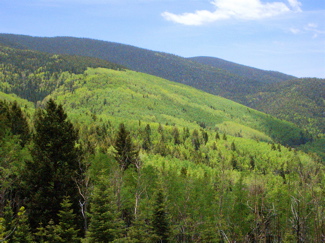 now on the planet and counting, that since we have officially entered the Anthropocene, an epoch named for the human induced changes to geology, that we may as well consider humanity to be the world’s ‘largest living thing’. I certainly lack the skills for measuring such a physical mass with scientific specificity, but science now acknowledges we are a biogeophysical force upon the plant, one currently far exceeding the transformational impacts of any other single species. And we now are responsible for more erosional movement of soil around than wind or water….
now on the planet and counting, that since we have officially entered the Anthropocene, an epoch named for the human induced changes to geology, that we may as well consider humanity to be the world’s ‘largest living thing’. I certainly lack the skills for measuring such a physical mass with scientific specificity, but science now acknowledges we are a biogeophysical force upon the plant, one currently far exceeding the transformational impacts of any other single species. And we now are responsible for more erosional movement of soil around than wind or water….
There is a deeper point here however and it is this: As humans we are culturally trained and entrained (speaking of the dominant cultural model) to see ourselves as individuals, as beings separate from each other… and therein is our common wounding. We learn to perceive ourselves as separate from each other and from the world of the forest and river and so experience that loneliness, isolation and anomie. The inevitability of this wounding is embedded within our dominate mythological religious and scientific worldviews; they encode within us models of perceptual fragmentation.
The lack of morality decried by the religious right, by fundamentalists of Christian or of Islamic persuasion…, is born and nurtured out of the very worldview of fragmentation they  espouse—of human kind as separate from, as fallen from, God.
espouse—of human kind as separate from, as fallen from, God.
The Aspen tree suggests to us a different worldview and vision. The Aspen grove presents us with the biological, psychological and metaphysical reality that the egoic self is a construct. It is a construction of our imaginations; and it is real. And so is the fact that we each are present in this moment of time and history as ramets of the Tree of Life, sprouting like human Aspen shoots, into the world of our perception.
Change your perceptions and change your world. We are what we perceive?
Perhaps we would do well to listen to the Aspen and learn to perceive the world through their lens of wholeness. There, individuality is honored while the experiences of separation and isolation and fragmentation dissolve in the midst of community, connectedness and belonging. From that place below the surface of normal perception, where all things are connected, not only does real change becomes possible, but the resources of transformation too becomes ours for the claiming.
Resource Notes:
The willingness and capacity and skill sets required to drop into that place of depth, as a social technology, is part and parcel of many of the world’s Indigenous traditions. Ohky Simine Forest is one Native American woman working to restore these traditions through the Red Wind Councils. Marc Choyt, friend and colleague, explores this territory through the eyes of a successful small business man at his blogs: the circle manifesto and at fair trade jewelry.
The resource of wholeness as a social technology of profound innovation and change is also being pioneered by The Presencing Institute. Peter Senge, Otto Schramer, Joseph Jaworski and Betty Sue Flowers plowed this territory with their book Presence. Otto Schramer’s new book, Theory U, takes us yet deeper into the resources of vitality and creativity that lie awaiting the presence of our arrival; it is a world of deep resource and connectivity living in the deep soil of our Self, and of our self.
Note: this post is the first in a body of work I call Aspen-Body Wisdom: the Wholeness of a Self in a Fragmented World. The essential perceptions presented herein form the essence of some of what I am working with in conferences and workshops and wilderness experiences these days.

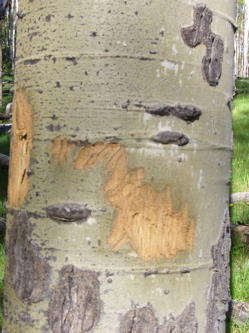
Marc Choyt
08/22/2007 at 7:58 pmLarry,
This post really rings true to my heart. I love what you say.
There’s so much to say… here’s just a few thoughts in response.
How does the tree metaphor differ from the evolution of human beings, of human consciousness? I think this is an important issue to explore in another piece, because they are not the same. Our ways of moving through the world, our sense of time and season, is different from that of an aspen. My Native teachers have taught me to honor the tree as a being equal in its life to my own having certain medicine that can help bring me, as a human being, back into greater balance. The throws me into a sacred relationship with the world which I admit is a very high bar that is difficult to maintain. Reciprocity, giving back, is the way to generate prosperity. Wealth is measured in how deeply connected you are to the web of life.
Second, I’d like to make the distinction between loneness and solitude. For myself, spending time alone can and often is the easiest way for me to get back in touch with feeling deeply connected.
Third, I’m thinking about authenticity in a really simple way today. Every moment I have to make decisions. Is my decision going to lead me into a deeper sense of empathy and connection to all that is around me or is it going to lead me to separation? It is a radical way to approach business decisions. The heart, its sensitivity and ability to feel and know what is connected and what is a violation of its beingness, is the eye through which one views the decisions.
Paula Underwood, one of my teachers, talked about trying to be mainly who we want to be as a process, not an end goal, because life is always throwing its curve balls if one is leaning into the mystery of it, so it is impossible to be absolutely on one’s true path all the time.
White Combs and Sweet Honey from my Old Failures « wild resiliency!
08/23/2007 at 5:00 pm[…] wild resiliency! for the love of life—go wild, be wild, stay wild! « Loneliness & Presence: What the Aspen Know […]
Resiliency and Shamanism « wild resiliency!
08/29/2007 at 11:18 pm[…] relation to this last quote, note the earlier post here, Loneliness and Presence: What the Aspen Know (they are of the same family of trees as the […]
Levels of Resiliency « wild resiliency!
09/07/2007 at 8:27 pm[…] The absence of the wellbeing of the other than human world in business models of resilience leads to unintelligent risk management. Short-term profits may be gleaned, but the wealth-of-sufficiency, and the wholeness-of-mind and of spirit and of body, require the hardiness and biognosis that can only come from knowing what the Aspen Grove knows. […]
Varieties of Resilience — The Resiliency of a Victim « wild resiliency blog!
09/21/2007 at 11:58 pm[…] a self that requires dying—in order that we may come to the joy and resource of knowing what the Aspen Knows, for we all have become victims to a worldview in which we are less than we are. We are left with […]
Forbidden Knowledge and the Aspen Body « wild resiliency blog!
10/13/2008 at 9:11 am[…] now believe to be the largest individual organism on the planet. (I propose an alternative view here.) It turns out that Aspens dwarf the redwood and the whale, and even the massive and extensive […]
A Walkabout into Collective Consciousness « wild resiliency blog!
10/27/2008 at 3:41 pm[…] constellation of the collective.” This bit of wild wisdom is also inherent and vital within the Aspen-Body Wisdom material that plays me, as is indeed are the themes of collective consciousness, collective […]
Aspen-Body Wisdom Archive « wild resiliency blog!
11/04/2008 at 11:26 pm[…] Loneliness & Presence: What the Aspen Know, August 22, 2007 […]
Heart Opportunity Knocking — At Your Door! « wild resiliency blog!
11/28/2008 at 8:52 am[…] dedicated to the Aspens, and to Sheva, both true through to their […]
Happiness and Health Research In: Nurture Friendship! « wild resiliency blog!
12/24/2008 at 6:11 am[…] Happiness and Health Research In: Nurture Friendship! By Larry Glover This, from Lynne McTaggert’s blog, reminds me of a post here: Lonliness and Presence—What the Aspen Know. […]
Sleeps with Elk « Fat Finch–Birds, Birding & Blogging
10/17/2009 at 1:06 am[…] background music. For elk and their love of Aspen, see The Ecology of Death. And don’t miss this from Wild Resiliency, which, in addition to explaining what it is that Aspen know, also has a […]
Oh this heart… « wild resiliency blog!
10/23/2010 at 1:30 pm[…] And here is a link from an earlier post on this blog: Loneliness & Presence: What the Aspen Know […]